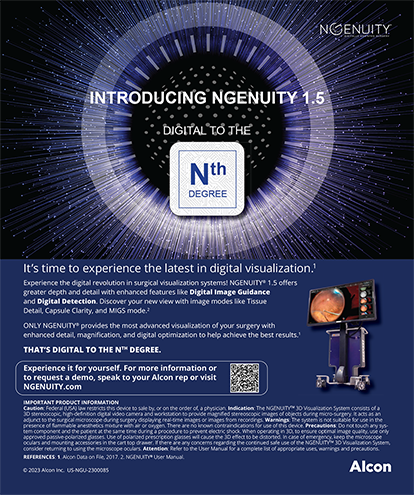Cover Stories | Mar 2006
Combining Multifocal IOLs
Implanting a Rezoom lens in one eye and an Acrysof Restor IOL in the other resolves intermediate deficiencies.
Frank A. Bucci, Jr, MD
This article reports the results of a study I conducted in which cataract and refractive lensectomy patients received either bilateral Acrysof Restor IOLs (Alcon Laboratories, Inc., Fort Worth, TX) or a Rezoom lens (Advanced Medical Optics, Inc., Santa Ana, CA) in their nondominant eye and an Acrysof Restor IOL in their dominant eye. Cohort I (56 patients with bilateral Acrysof Restor IOLs) included 22 cataract patients (39%) and 34 refractive lensectomy patients (61%). The number of patients in cohort II, all of whom received a Rezoom lens in one eye and an Acrysof Restor IOL in the other, has grown to almost 50 at the time of this writing, but the data in this article are limited to those patients who have at least 10 weeks' follow-up (n = 21).
BACKGROUND
I began combining these multifocal lenses due to complaints about intermediate vision by 13 of 56 patients in whom I had implanted the Acrysof Restor IOL bilaterally. None of the first 40 patients receiving the two different multifocal lenses has voluntarily complained about his intermediate vision. My idea of combining the Rezoom and Acrysof Restor IOLs derived from my results in five patients with a unilateral multifocal Array lens (Advanced Medical Optics, Inc.) who later received an Acrysof Restor IOL in their second eye. They were thrilled with their increased ability to read without additional halos.
CASE STUDIES
Cohort I
After the bilateral implantation of the Acrysof Restor IOL, the following four patients essentially achieved a distance UCVA of 20/20 in each eye and also a near UCVA of J1 with a focal point of between 10 and 12 inches.
Case No. 1
A 48-year-old female with high myopia achieved a bilateral intermediate UCVA of J6 at 5 months postoperatively. She complained bitterly that, at her office, she could neither see her computer at arm's length to her right nor a special, low lying desk that was at approximately arm's length on her left. She wore +1.25D readers for 8 hours per day for many months and now uses a +1.50D contact lens in one eye.
Case No. 2
A 72-year-old male was approximately +3.00 +1.25 in both eyes preoperatively. He had J5/J4 unilaterally and J4 bilateral uncorrected intermediate vision at arm's length postoperatively. Almost 5 months after surgery, the patient vehemently complained that he could not view his computer at work.
Case No. 3
A 64-year-old moderately myopic female had uncorrected unilateral intermediate vision of J6/J5 at arm's length, and her bilateral uncorrected intermediate vision was J5. She stated that she had “no counter vision” and “no cooking vision” at home.
Case No. 4
A 51-year-old male with moderate myopia had uncorrected intermediate vision of J6/J6 unilaterally and J5 bilaterally at arm's length. Although he was thrilled with his postoperative distance and reading vision, he stated that he was “having great difficulty with his woodworking” without functional intermediate vision.
Cohort II
A 58-year-old male with 4.50D of myopia preoperatively underwent the implantation of an Acrysof Restor IOL in his left eye. Following surgery, he saw 20/20 at distance and J1 at 12 inches. His uncorrected intermediate vision was J6. He reported, “I would be unable to tolerate two eyes like this.” Two weeks after receiving the Rezoom multifocal implant in his right eye, he had 20/20 uncorrected distance vision bilaterally and J1 uncorrected near vision in both eyes. His uncorrected intermediate vision was J2 in the Rezoom eye and J6 in the eye with the Acrysof Restor IOL. His uncorrected, bilateral intermediate vision was J1.
The patient was extremely happy and stated that, as I had predicted, he could easily see his computer but still had outstanding uncorrected distance and reading vision.
VISUAL OUTCOMES
The mean bilateral Jaeger near vision was 1.02 in cohort I versus 1.05 in cohort II—obviously not a significant difference. In contrast, the mean bilateral Jaeger uncorrected intermediate vision in cohort I was J3.58, significantly (P=.0001) less than the J2.29 of cohort II (Figure 1). The mean unilateral Jaeger intermediate vision (J4.19) for the 90 eyes with the Acrysof Restor IOL in cohort I (Figure 2) was identical to the mean unilateral intermediate vision of the 21 eyes with that lens in cohort II (Figure 3). The mean unilateral intermediate Jaeger vision in cohort II for the 21 eyes with the Rezoom lens was J2.81, which was statistically significantly better than the J4.19 observed in the individual eyes with the Acrysof Restor IOL (Figure 3).
COMPLAINTS
Age, culture, and patients' expectations seemed to greatly influence the incidence of complaints related to intermediate vision. An analysis of the 13 complaints in cohort I revealed that 10 of the patients had undergone refractive lensectomy and that these 10 were all less than 60 years of age. One-third of all of the patients who were 60 years of age or younger had a complaint about their intermediate vision, and all of them had undergone a refractive lensectomy (Figure 4).
I think that the use of bilateral Acrysof Restor IOLs in young refractive lensectomy patients has not been sufficiently studied. The 457 patients who received the lens in its FDA trial were all cataract patients with an average age of greater than 68 years. Current users of this multifocal lens have a cataract/refractive lensectomy patient-type ratio of greater than 10:1. Cataract patients in the FDA study paid nothing for their surgery, and they now pay one-third to one-half less than refractive lensectomy patients. Cataract patients from “the greatest generation” are less likely to complain, less likely to use computers, less active, and less litigious than baby boomers. Moreover, cataract patients experience significantly improved vision just from the removal of their cataract. Because the Acrysof Restor IOL gives them uncorrected near vision that they did not have, they are less likely to complain about difficulties with intermediate vision.
In contrast, patients under 60 years of age pay between $7,000 and $10,000 for two multifocal implants with refractive lensectomy. They are likely to be demanding, active, computer literate, outspoken, and litigious, and they will complain. In my study, whereas 37% of the patients in cohort I had J3 or better bilateral intermediate vision, 63% saw J4, J5, or J6. Eleven of the 13 patients with intermediate complaints had bilateral intermediate vision from J4 to J6.
CONCLUSION
Placing a Rezoom lens in the patient's nondominant eye essentially eliminated intermediate complaints without inducing any intolerable increases in nighttime light phenomena. Moreover, whereas the Acrysof Restor IOL provides excellent reading vision in bright light, the Rezoom lens gives patients very good reading vision in moderate and dim light. The Rezoom lens also provides excellent distance vision in bright daylight, whereas the Acrysof Restor IOL contributes to distance vision for nighttime driving without significantly increasing the amount of halos.
Frank A. Bucci, Jr, MD, is Medical Director of Bucci Laser Vision Institute in Wilkes-Barre, Pennsylvania. He has received grants from Advanced Medical Optics, Inc. Dr. Bucci may be reached at (570) 825-5949;
buccivision@aol.com.


